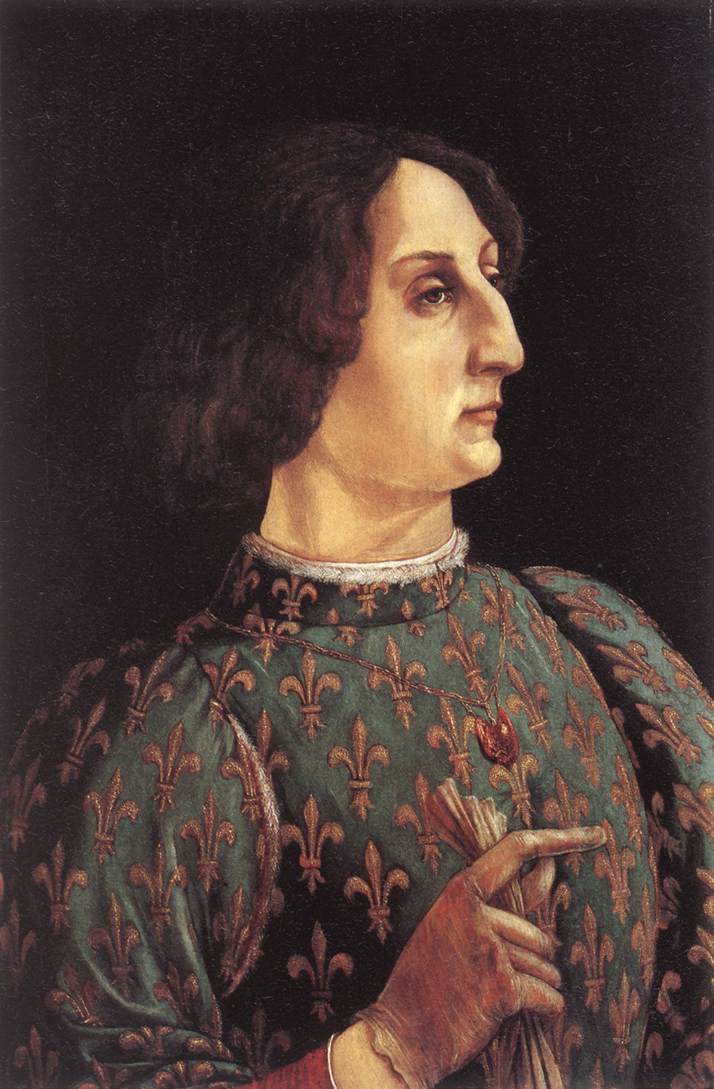<Back to Index>
- Economist Oskar Morgenstern, 1902
- Playwright Pierre de Beaumarchais, 1732
- Duke of Milano Galeazzo Maria Sforza, 1444

Galeazzo Maria Sforza (January 24, 1444 – December 26, 1476) was Duke of Milan from 1466 until his death. He was famous for being lustful, cruel and tyrannical.
He was born to Francesco Sforza, a popular condottiero and ally of Cosimo de' Medici who had gained the dukedom of Milan, and Bianca Maria Visconti. He married into the Gonzaga family, and on the death of his wife Dorotea, married Bona di Savoia. Gian Galeazzo was born in Fermo, near the family's castle of Girifalco, the first son of Francesco Sforza and Bianca Maria Visconti. At the death of his father (March 8, 1466), Gian Galeazzo was in France at the head of a military expedition to help King Louis XI of France against Charles I of Burgundy.
Called back home by his mother, Galeazzo returned to Italy by an
adventurous trip under a false name, as he had to pass by the
territories of the family enemy, the Duke of Savoy, who made an
unsuccessful attempt on his life. He entered Milan on March 20,
acclaimed by the populace. There were three principal assassins involved in Sforza's death: Carlo Visconti, Gerolamo Olgiati and Giovanni Andrea Lampugnani, all fairly high-ranking officials in the Milan court. Lampugnani,
descended from Milanese nobility is recognized as the leader of the
conspiracy, his motives based primarily on a land dispute, in which
Galeazzo failed to intervene in a matter which saw the Lampugnani
family lose considerable properties. Visconti and Olgiati also bore the
duke enmity - Olgiati was a Republican idealist,
whereas Visconti believed Sforza to have taken his sister's virginity.
After carefully studying Sforza's movements, the conspirators made
their move on the day after Christmas,
1476, the official day of Santo Stefano, the namesake of the church
where the deed was to be committed. Supported by about thirty friends,
the three men waited in the church for the duke to arrive for mass.
When he arrived, Lampugnani knelt before him, and after some words were
exchanged, rose suddenly, stabbing him in the groin and breast. Olgiati
and Visconti soon joined in, as did a servant of Lampugnani's. Sforza
was dead within a matter of seconds, and all the assassins quickly
escaped the ensuing mayhem, save for Lampugnani, who became entangled
in some of the church's cloth and was killed. His body soon fell into
the hands of a mob, which dragged it through the streets, slashing and
beating at it and in the end, hanging it upside-down outside his house.
The beheaded corpse was cut down the next day and, in an act of
symbolism, the "sinning" right hand was removed, burnt and put on
display. The
conspirators had given little thought as to the repercussions of their
crime, and were apprehended within days. Visconti and Olgiati were soon
found and executed, as was the servant of Lampugnani who had
participated in the slaying, in a public ceremony which culminated in
their corpses being displayed as warnings to others. Evidence from the conspirators' confessions indicated that the assassins had been encouraged by the humanist Cola Montano,
who had left Milan some months before, and who bore malice against the
duke for a public whipping some years before. Olgiati also uttered the
famous words, while being tortured, "Death is bitter, but glory is
eternal." Similar elements indicate that this assassination was likely influential in the Pazzi Conspiracy, a subsequent attempt to dethrone the Medici family in Florence and to replace them with Girolamo Riario.
Sforza
was famous as a patron of music. Under his direction, financial backing
and encouragement, his chapel grew into one of the most famous and
historically significant musical ensembles in Europe. Some of the figures associated with the Sforza chapel include Alexander Agricola, Johannes Martini, Loyset Compère, and Gaspar van Weerbeke.
Most of the singers at the chapel fled after Galeazzo's murder,
however, and took positions elsewhere; soon there was a rise in musical
standards in other cities, such as Ferrara, as a result.
Despite
his love of music, Sforza is also known to have had a cruel streak. He
was a notorious womanizer who often passed his women on to his
courtiers once he was tired of them. He once had a poacher executed by
forcing him to swallow an entire hare (with fur intact), had another man nailed alive to his coffin, and a priest who
had predicted a short reign was punished by being starved to death.
This made him many enemies in Milan. It was also said of Sforza that he
had raped the wives and daughters of numerous Milanese nobles; that he
took sadistic pleasure in devising tortures for men who had offended
him and that he enjoyed in pulling apart the limbs of his enemies with
his own hands.